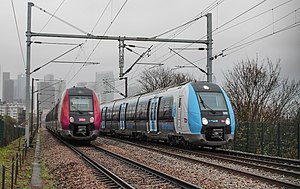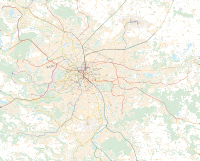SNCF Class Z 50000
| Z 50000 | |
|---|---|
 A pair of Z 50000 trainsets in the older livery (left) and the STIF/ÎdFM livery (right) | |
| In service | 2009-present |
| Manufacturer | Bombardier Transportation |
| Built at | Crespin |
| Replaced | BB 17000 RIB Z 6400 VB2N Z20500 |
| Entered service | 14 December 2009 |
| Number under construction | 360 trainsets[1] |
| Number in service | 305 trainsets (as of 25 April 2021) |
| Formation | 7 or 8 cars per trainset 134 trainsets with 7 cars 143 trainsets with 8 cars (all as of July 2020) |
| Capacity | Seated: 405† / 503* Standing: 468† / 552* (at 4 per square metre) |
| Operator(s) | SNCF |
| Depot(s) |
|
| Line(s) served | |
| Specifications | |
| Car body construction | Stainless steel |
| Train length | 94.3 m (309 ft 5 in)† 112.5 m (369 ft 1 in)* |
| Car length | 16.53 m (54 ft 3 in) (end car) 13.24 m (43 ft 5 in) (intermediate cars) |
| Width | 3.06 m (10.0 ft) |
| Height | 4.28 m (14 ft 1 in) |
| Entry | 985 mm (38.8 in) |
| Doors | 1,950 m (6,397 ft 8 in) |
| Wheel diameter | 840 mm (33.07 in) |
| Wheelbase | 1.9 m (75 in) |
| Maximum speed | 140 km/h (87 mph) |
| Weight | 210,000 kg (460,000 lb)† 240,000 kg (530,000 lb)* |
| Traction system | Bombardier MITRAC IGBT-VVVF |
| Traction motors | 3-phase AC asynchronous bi-motors |
| Power output | 2,950 kW (3,960 hp)* (2,620 kW (3,510 hp) continuous) |
| Acceleration | 1 m/s2 (3.3 ft/s2) (0 to 50 km/h or 0 to 31 mph)* |
| Deceleration | 1.05 m/s2 (3.4 ft/s2)* (service brakes) |
| Electric system(s) | 1,500 V DC or 25 kV 50 Hz AC, both from overhead catenary |
| Current collection method | Pantograph Type AX |
| Bogies | FLEXX Compact |
| Braking system(s) | Disc, dynamic and regenerative |
| Safety system(s) | Crocodile and KVB |
| Coupling system | Scharfenberg type |
| Multiple working | Z 50000 |
| Track gauge | 1,435 mm (4 ft 8+1⁄2 in) standard gauge |
| Notes | |
| † Seven car train, * Eight car train Sources:[2][3][4] | |
The SNCF Class Z 50000 (Technical Name), also known as the 'Francilian' (Operating Name), or 'NAT' (Project Name for French: Nouvelle Automotrice Transilien, English: New Rail car Transilien) is a type of dual-voltage electric multiple unit trainset designed in the 2000s. It is commuter rail system serving Paris and its Île-de-France suburbs on the Transilien network. Departing stations are Gare du Nord, Gare de l'Est and Gare Saint-Lazare.
A total of 360 trainsets have either been built or are under construction by Canadian conglomerate Bombardier at its Crespin, France (near Valenciennes) factory since 2006. The first set was placed into regular passenger service on 14 December 2009.
The name Francilien is also the demonym for people living in Île-de-France.
History[]
In 2004, the Syndicat des transports d'Île-de-France (STIF, the transit authority for the Paris region until June 2017) began the tendering process for approximately 180 new electric multiple unit trainsets to replace SNCF's aging single-deck suburban fleet, including trainsets nicknamed “inox” (short for inoxydable, English: stainless [steel]) (Classes Z 5300, , Z 6400) and similar push-pull trainsets known as RIB () and RIO (). The SNCF and STIF requested bids for a train design that could operate on a typical journey of 30 to 50 kilometres (19 to 31 miles) in length, including numerous stops lasting 30 to 40 seconds, and able to operate from either 1.5 kV DC or 25 kV AC overhead catenary electrification.[5]
Alstom, Bombardier, and Siemens all submitted bids for the project.[6] In 2006, SNCF (French Railway Company) and Syndicat des transports d'Île-de-France (STIF, the transit authority for the Paris region until June 2017) awarded the contract to Bombardier with a firm order for 172 ‘Francilien’ trainsets at a cost of €1.85 billion, with an option for 200 more.[2][3]
Bombardier presented the vehicle at Crespin on 6 February 2009.[7] The first service operated by a Francilien train was on Transilien Line H from Paris Gare du Nord to Luzarches on Sunday 13 December 2009.[8] As of December 2018, 360 trainsets had been ordered, and about 240 were in active service.[9]
Design[]
Bombardier vehicle design is articulated using Jakobs bogies between the carriages. Seating is in a 3+2 layout giving over 400 seats in a seven-car unit, over 500 in an eight-car set. Total capacity exceeds 800 (or 1,000 in eight-car trains) including standing passengers at 4 per square metre (3.3/sq yd). The vehicle's width is 3.06 metres (10.0 ft), which is wider than previous trains, achieved by having a relatively short car length of 13.24 metres (43 ft 5 in).[5][4] The inter-carriage passages have wide, open gangway connections, limiting bottlenecking.[4] All interior lights are provided by light-emitting diodes (LED), so power consumption is lessened.[5]
Photo gallery[]

Interior, showing 3+2 seating

Interior, showing open gangway connection

Gap filler allowing easy access for wheelchair users

SIVE dynamic passenger information screens

Operator's cab

Z 50000 in the new Île-de-France Mobilités livery on Transilien Line H at Bessancourt station

Z 50000 in the older Carmillon livery on Transilien Line L at Cergy-Saint-Christophe station
See also[]
References[]
- ^ Liste des Z 50000 sur le site Trains du Sud-Ouest.
- ^ Jump up to: a b Dossier de Presse (28 mars 2008) Visite à Crespin (Nord) de la ligne de fabrication du Francilien (PDF) (in French), STIF, 28 March 2008, archived from the original (PDF) on 7 September 2008
- ^ Jump up to: a b "Paris prepares for the Spacium age". International Railway Journal. September 2008. pp. 29–32.
- ^ Jump up to: a b c "SPACIUM 3.06 - Ile-de-France commuter train". Bombardier Transportation.
- ^ Jump up to: a b c "L'automotrice "Francilien", futur matériel pour l'Île-de-France"", (in French) (172), pp. 7–16, May 2008, ISSN 0035-3183
- ^ Des trains modernisés sur le réseau Transilien (PDF), Syndicat des Transports d'Ile-de-France, 24 March 2006, 3. Nouvelle Automotrice Transilien (NAT), archived from the original (PDF) on 3 March 2013
- ^ "Spacium готов к испытаниям" (PDF), Железные дороги мира (ЖДМ) (in Russian) (3), pp. 31–36, 2009[permanent dead link]
- ^ First run for the Francilien, SNCF, 11 December 2009
- ^ "Paris commuter EMUs ordered". Railway Gazette International. 27 December 2018. Retrieved 28 December 2018.
Literature[]
- "De la NAT au Francilien : la genèse d'un projet mené tambour battant", (in French) (153), pp. 46–65, July 2010, ISSN 1261-3665
- "Ввод в обращение - первых поездов Francilien" (PDF), Железные дороги мира (in Russian) (4), pp. 32–37, 2010[permanent dead link]
- Jackson, C (2010), Railway Gazette International (2), pp. 55–58 Missing or empty
|title=(help) - Пригородный - электропоезд новой концепции (PDF), Железные дороги мира (in Russian) (10), pp. 36–8, 2007[permanent dead link]
- Hughes, M. (2007), Railway Gazette International (9), p. 574 Missing or empty
|title=(help)
| Wikimedia Commons has media related to SNCF Class Z 50000. |
- SNCF multiple units
- Bombardier Transportation multiple units
- Articulated passenger trains
- Electric multiple units of France
- Train-related introductions in 2009








